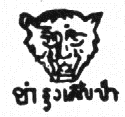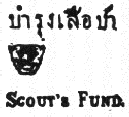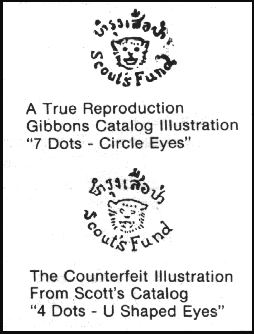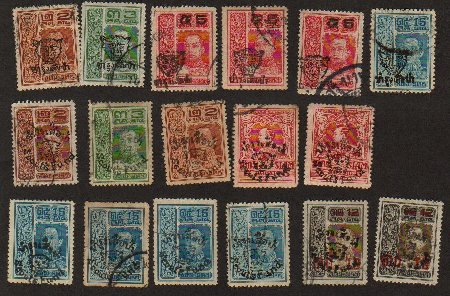Collectors see more and more different kinds of Siam Scout Fund overprint forgeries because genuine overprinted stamps are scarce while the stamps without the Scout overprint are quite common. Descriptions are provided in this article to assist in the identification of the many types of known forgeries. My comments are based on the examination of several thousand Siam Scout overprinted stamps by members of the Siam Study Group.



The Scott's Catalog Forgeries Many Type II fakes can be recognized because the handstamp design is based on the illustration from the Scott's Catalog shown above. These illustrations are not reproductions of the real overprints but are simply redrawings, only superficially similar in appearance. If your overprint set is very uniform and identical in design with the Scott Catalog then you own a set of counterfeits. Two major differences that can just about be picked up without a magnifying glass: the genuine overprint has seven dots on the forehead of the tiger and circular eyes. The counterfeit from the catalog illustration has four dots on the forehead and sideways "U" shaped eyes, opened at the nose.
The Star Forgeries Many stamps with the same type of overprint forgery have the outline of a five-pointed star rubber-stamped on the back of the stamp. Although the star could possibly be of any color, the colors which we have seen are primarily red, or black. Star forgeries have been most often seen when the stamp appears to have a Type I Scout overprint. We have examined scores of overprinted stamps with star marks on the back; none were on stamps with genuine overprints.
The Taw-Tah-hahn Forgeries We have seen scores of stamps with the letter "taw tah-hahn" of the Thai language on the back of the stamps. It occurs with all three Siam Scout overprint types. To date, no taw tah-hahn examined has been on a stamp having a genuine Scout overprint. Although it is not necessarily the same size, this letter has the general shape as the following two examples:

The "Scont's" Forgery One would expect that misspelling would not occur when forging a stamp. Nevertheless, a spelling error occurs on a forged overprint of the Type II stamps. In this well known case, an "n" replaces the "u" in "Scout's". The Scont's forgery is known to be printed on each of the six Type II values.
A Black Ink Forgery The characteristics of the overprint ink are usually examined when inspecting for the genuineness of an overprint on a stamp. And the color of the ink is one of the most important of these. The genuine Type III overprints are printed in either red or blue ink, depending on the face value. There are no genuine Scout's Fund Type III overprinted stamps known in which the overprint is in black ink. Such stamps overprinted in black ink are forgeries.

'Size' Forgeries If you have more than one Siam Scout stamp with the Type II or Type III overprint, and the size (height and/or width) is different between any two of these overprints of the same type, there is a high probability that at least one of the overprints may not be genuine. Further examination would be needed to identify which may not be the correct size.
The 'Wrong Stamp' Forgeries If the overprint is printed on a stamp that has not been identified in the catalogs as a stamp with a Scout's Fund overprint, then, although there are a very few known exceptions, the overprint is probably a forgery. While further research is needed to be specific about whether the 1912 Vienna printing or the 1918 London printing, some forged overprints are on stamps which either have a wrong surcharge value or are simply not a stamp that was overprinted for the Scout's fund.
Certificate with Embossed Photo Are you concerned if a specific Siam stamp has a genuine overprint? Then consider having the stamp expertized by sending for a certificate with embossed photo. Reputable philatelic organizations issuing such expert certificates include the American Philatelic Society and the Royal Philatelic Society in London. A mark printed or stamped on the back of a Siam stamp is not an adequate substitute for a reputable organization's certificate with embossed photo.
SOSSI Journal, Volume 26, Number 11-12, November/December 1977
SOSSI Journal, Volume 39, Number 1, January 1990
SOSSI Journal, Volume 41, Number 3, March 1992
Updates and Modifications by Keith Larson


